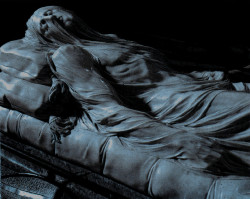


In the heart of the historical center of Naples, in the Sansevero Chapel is guarded the Veiled Christ, one of the most famous and evocative works in the world. According to the client’s intentions, the statue was to be made by Antonio Corradini, who had already sculpted Pudicizia for the prince. However, Corradini died in 1752 and had time to finish only a terracotta sketch of Christ, now preserved in the Museum of San Martino. For this reason Raimondo di Sangro commissioned a young Neapolitan artist, Giuseppe Sanmartino, to create “a life-size sculpted marble statue, representing Our Lord Jesus Christ dead, covered by a transparent shroud made from the same block as the statue”. account of the previous sketch by the Venetian sculptor. As in the Pudicizia, even in the veiled Christ the original stylistic message is in the veil, but the heartbeats and late baroque feelings of Sanmartino give the shroud a movement and a meaning very distant from the Corradin canons.

The modern sensitivity of the artist sculpts, fleshes the lifeless body, which the soft coulters mercifully collect, on which the tormented, convulsive rhythms of the folds of the veil affect a profound suffering, as if the pitiful covering made the poor even more naked and exposed limbs, even more inexorable and precise the lines of the battered body. The swollen and still throbbing vein on the forehead, the piercings of the nails on the feet and on the thin hands, the ribs dug and relaxed finally in the liberating death are the sign of an intense research that does not give space to preciousness or school fees, even when the sculptor “embroider” the edges of the shroud meticulously or dwell on the instruments of the Passion placed at the feet of Christ. The art of Sanmartino ends here in a dramatic evocation, which makes the suffering of Christ the symbol of destiny and the redemption of all humanity.
